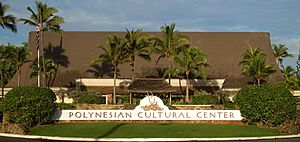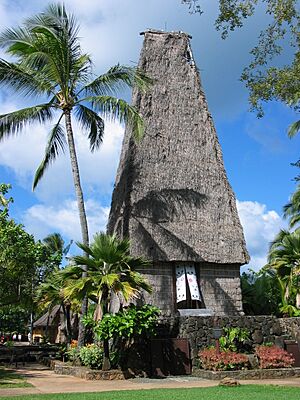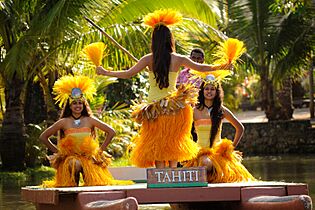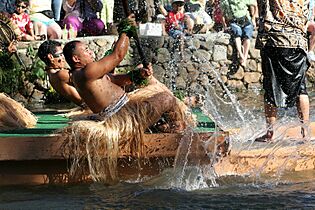Polynesian Cultural Center facts for kids
 |
|
| Location | 55-370 Kamehameha Highway, Laie, Hawaii, U.S. |
|---|---|
| Coordinates | 21°38′20.63″N 157°55′12.97″W / 21.6390639°N 157.9202694°W |
| Status | open |
| Opened | October 12, 1963 |
| Owner | Corporation of the President of The Church of Jesus Christ of Latter-day Saints |
| Slogan | One Ohana Sharing Aloha |
| Area | 42 acres (17 ha) |
The Polynesian Cultural Center (PCC) is a special place in Laie, on the island of Oahu, Hawaii. It's like a living museum where you can learn about the cultures of Polynesia. The PCC is owned by the Church of Jesus Christ of Latter-day Saints. It opened on October 12, 1963. The center covers 42 acres of land. This land belongs to Brigham Young University–Hawaii (BYU-Hawaii), which is nearby.
The PCC has eight villages that look like real villages from different Polynesian islands. Here, performers show off traditional arts and crafts. Visitors can also take a free tour of the university. They can also see the Church's Laie Hawaii Temple and its visitor center.
About 70% of the PCC's 1,300 employees are students from BYU-Hawaii. Since it opened, the PCC has helped over 12,000 students pay for their education. Students can work up to 20 hours a week during school. During breaks, they can work up to 40 hours. The PCC is a non-profit organization. This means all the money it earns goes back into running the center and helping students.
Contents
History of the Polynesian Cultural Center
In early 1962, David O. McKay, who was the leader of the Church, approved building the center. He wanted it to help students at BYU-Hawaii get jobs and scholarships. He also wanted it to help keep Polynesian cultures alive. The idea for the center started in the 1940s and 1950s. Back then, people held beach parties called hukilau and luau to raise money. They needed to rebuild a local church that had burned down. The famous song "The Hukilau Song" was written after a visit to one of these parties.
In October 1980, Xi Zhongxun, a leader from China, visited the PCC. He was touring the United States at the time. After the September 11 attacks in 2001, fewer people visited the PCC. So, in 2004, the center spent twice as much money on advertising. They wanted to promote local music, dance, and food events.
The PCC is one of the most popular places to visit in tourism in Hawaii. About 700,000 people visit it every year. The PCC also hosts the yearly World Fire Knife Dance Competition. In this event, people show off their amazing skills with flaming swords. Since it opened in 1963, more than 32 million people have visited the center. Howard W. Hunter is known for helping the PCC become one of Hawaii's top tourist spots.
Activities at the Polynesian Cultural Center
Evening Show: Hā–Breath of Life
Besides the daytime activities, the PCC has a big evening show. This show costs extra to see. Since 2009, the show has been called Hā–Breath of Life. The New York Times newspaper called it "a vivid, energetic production." It shows off songs and dances from different cultures in the South Pacific. The show includes dances like the hula, tamure, otea, titi torea, haka, poi, meke, tauʻolunga, and Taualuga. Earlier shows included "This is Polynesia" and "Mana: The Spirit of Our People." The show has about 100 performers. They perform six evenings every week.
Canoe Parade: Huki: A Canoe Celebration
There is a lagoon at the PCC where a parade of canoes takes place. Each canoe shows off the special dances of a Polynesian culture. The current show is called Huki: A Canoe Celebration. It started in August 2018. Before that, there were shows like Rainbows of Paradise and Ancient Legends of Polynesia.
Exploring the Villages
Each main Polynesian culture has its own area at the PCC. These areas are designed like traditional villages. Every hour, there are performances and chances to learn about the culture in these villages. The villages include:
Besides the villages, the PCC has a special exhibit about Rapa Nui (Easter Island). There is also a tribute to a Church mission from the 1850s. Visitors can also enjoy a luau, which is a traditional feast. The Aliʻi Luʻau ("Royal Feast") offers Polynesian foods. This includes pork cooked in an imu, which is an underground oven. You can even see the roasted pig in the imu before the meal. The PCC also has its own special effects theater. And, of course, there's the lagoon where visitors can take canoe rides. You can have a guide or paddle by yourself.
Special Events
The PCC holds many special events. These events highlight Hawaiian, Samoan, Tahitian, and Māori cultures. They also have a Christmas festival. The PCC used to have a Haunted Lagoon event, but they stopped it in 2013. Other festivals include the Moanikeala Hula Festival and the World Fireknife Championships.
Images for kids
See also
- The Church of Jesus Christ of Latter-day Saints in Hawaii






